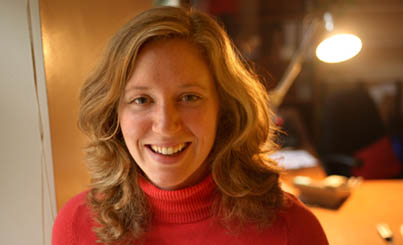Profile - Madeleine Bird: Bad chemistry, bad products
Profile - Madeleine Bird: Bad chemistry, bad products McGill University
User Tools (skip):
PROFILE
Madeleine Bird: Bad chemistry, bad products

According to Madeleine Bird, nothing beats vinegar and baking soda as all-purpose cleaners. "They work well, they're safe to use and they don't harm the environment."
OWEN EGAN
A couple looks on as a young girl plays dress-up, putting on her mother's clothes and applying makeup with the intense concentration only a five-year-old can muster. Imagine how quickly those smiles would disappear if the parents knew that the lipstick was laced with lead and the nail polish contained formaldehyde, a known carcinogen. The plot to Stephen King's most recent horror opus? No. A real and growing concern that is played out in countless homes every day throughout Canada and the US.
"It's ironic that cosmetics, something that can make us feel so fresh and beautiful, has the potential to make us very, very sick," says Madeleine Bird, coordinator of the Health and Environment Awareness Project, a collaboration between the McGill Centre for Research and Teaching on Women and the not-for-profit organization Breast Cancer Action Montreal (BCAM).
Part of Bird's mandate is to use seminars and workshops to educate the public about the potential dangers that may lurk in cosmetics and everyday household cleaning products in the form of toxic chemicals. Many of these chemicals are carcinogenic, while others may throw hormonal and reproductive systems out of whack, says Bird. Even more frightening is the fact that there are other chemicals present in such products about which there is virtually no long-term understanding. Russian roulette via face cream and air fresheners!
"We're seeing a huge increase in hormonally related cancers, like breast cancer, prostate cancer, thyroid cancer, uterine cancer," says Bird. "A lot of these toxic chemicals can disrupt our hormonal system, so there's an association between some of these chemicals and an increase in certain types of cancers."
Unfortunately, Bird knows too well the dangers inherent in regular exposure to toxic chemicals. She watched her stepfather succumb to non-Hodgkin's lymphoma when he was just 40 years old. "He grew up in farmers' fields in Southern Ontario that were full of pesticides. Sure enough, there is a link between non-Hodgkin's lymphoma and pesticides," she says. "Needless to say, this is something I'm very passionate about."
Surprisingly, for a country in which virtually every edible item must be labelled with a meticulous breakdown of ingredients, Canada isn't nearly as stringent with cosmetics. "Health Canada does not require cosmetics manufacturers to demonstrate the long-term or short-term safety of any of their products before they go on sale," says Bird.
While ingredient labels on cosmetics are a relatively new phenomenon here, being made mandatory only in 2006, perfumes remain above the law. To protect their secret recipes from competitors, fragrance manufacturers are exempted from labeling requirements. According to Bird, independent testing has shown that those secret recipes often include phthalates, a plasticizing compound that is used in the making a wide range of household products, from soap and shampoo to plastic bags and children's toys. According to the US Centres for Disease Control and Prevention, the possible health effects of exposure to phthalates are not yet fully known.
Unbelievably, says Bird, Canadian regulations governing household cleaners are even more lax. "Companies are only required to list acute hazardous ingredients that are above one percent, such as poisons and corrosive chemicals," says Bird. "But there is no concern about the long-term effects ingredients will have on our health. This is a serious right-to-know issue."
Bird says the situation gets even murkier when one considers how a number of companies that place a breast cancer pink ribbon on their products use ingredients that are known carcinogens. And what are parents to do when they hear or read reports that many of the sunscreens they slather onto their children to protect them from something like melanoma can cause hormonal disruption? "Children are much more vulnerable. Because their bodies are changing so quickly, there are more opportunities for the child's genes to mutate through this rapid change," says Bird.
The best weapon is education and action. While she spreads the word to the public about some of the steps they can take to reduce exposure to harmful chemicals (for example, she will teach you how to make your own lip gloss out of almond oil, cranberries, a little bit of vitamin E oil and honey), she also advocates taking the fight directly to the lawmakers. "Health Canada has to be more straightforward with its policies," says Bird. "We need to convince them to put warning labels that simply say ‘This product contains known carcinogens.' Then, as with cigarettes, consumers can make an informed decision to buy or not to buy."
"The second that type of labelling becomes mandatory, manufacturers would start taking the dangerous ingredients out of their products. We have a lot of power with our voice and we can change things in a positive way."
Bird will give a workshop on toxic chemicals in cosmetics on Nov. 23, 4 p.m.; Redpath Museum. For more information, go to www.mcgill.ca/redpath.

